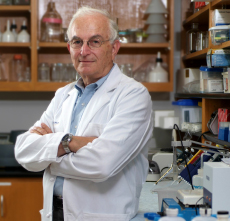The healing power of progesterone
More than 25 years ago, scientist Donald Stein (emergency medicine) noticed that female rats recovered better than male rats from brain injury.
 Donald Stein's research, which began more than 25 years ago, is headed into a phase III study on the effectiveness of progresterone for traumatic brain injury. |
The brain researcher thought the difference for females was the effect of progesterone, but he found little interest in this theory among his colleagues, who told him not to waste his time.
Still, he believed he was on to something, and he persisted. He spent decades doing his research in his spare time and with piecemeal funding. This past summer, he saw the fruits of his hard work when the medical school received $14.5 million in NIH funding to lead a phase III study in 15 states to evaluate the effectiveness of progesterone on patients with acute traumatic brain injury. Grady Hospital will serve as the lead center when the trial begins early this year.
An earlier study, called ProTECT (progesterone for traumatic brain injury—experimental clinical treatment) yielded positive results. "We found a 50% reduction in mortality in those patients treated with progesterone," says David Wright (emergency medicine), who also will lead the new study. "We also found signs that progesterone improved functional outcomes and reduced disability in patients with moderate brain injury."
Progesterone is naturally present in small but measureable amounts in human brains, and brain tissue is loaded with progesterone receptors. Laboratory studies suggest that progesterone is critical for normal development of neurons in the brain and exerts protective effects on damaged brain tissue. Approximately 1.5 to 2 million Americans suffer a traumatic brain injury each year, leading to 50,000 deaths and 80,000 new cases of long-term disability.
"Many people do not realize that it's not just a female hormone; both men and women produce progesterone directly in the brain, as well as other tissue," says Stein, who directs the brain research lab in emergency medicine. "Ultimately, we learned that progesterone basically does in brain injuries what it also does during fetal development—protect cells and tissue. To now witness the translation of this laboratory research into a treatment that may have live-saving benefits is breathtaking."
|
Stein is continuing to research progesterone. In collaboration with Dennis Liotta, Emory professor of chemistry and a codiscoverer of Emtriva for HIV, Stein has found some progesterone analogues that are water-soluble. Currently, the lack of water solubility limits delivery of progesterone. The hormone must be prepared hours ahead and cannot be kept at roomtemperature. Small chemical modifications may allow similar compounds with the same effects as progesterone to be given to patients closer to the time of injury. According to his research, two compounds similar to progesterone reduced brain swelling just as well as progesterone did in an animal model of traumatic brain injury. Stein also has found that adding vitamin D to progesterone enhances the hormone's effectiveness. Like progesterone, vitamin D is a steroid hormone that is inexpensive and safe and acts on many different biochemical pathways. A small amount of vitamin D boosted progesterone's ability to protect neurons from excito-toxicity, a principal cause of brain injury and cell death. |
||


